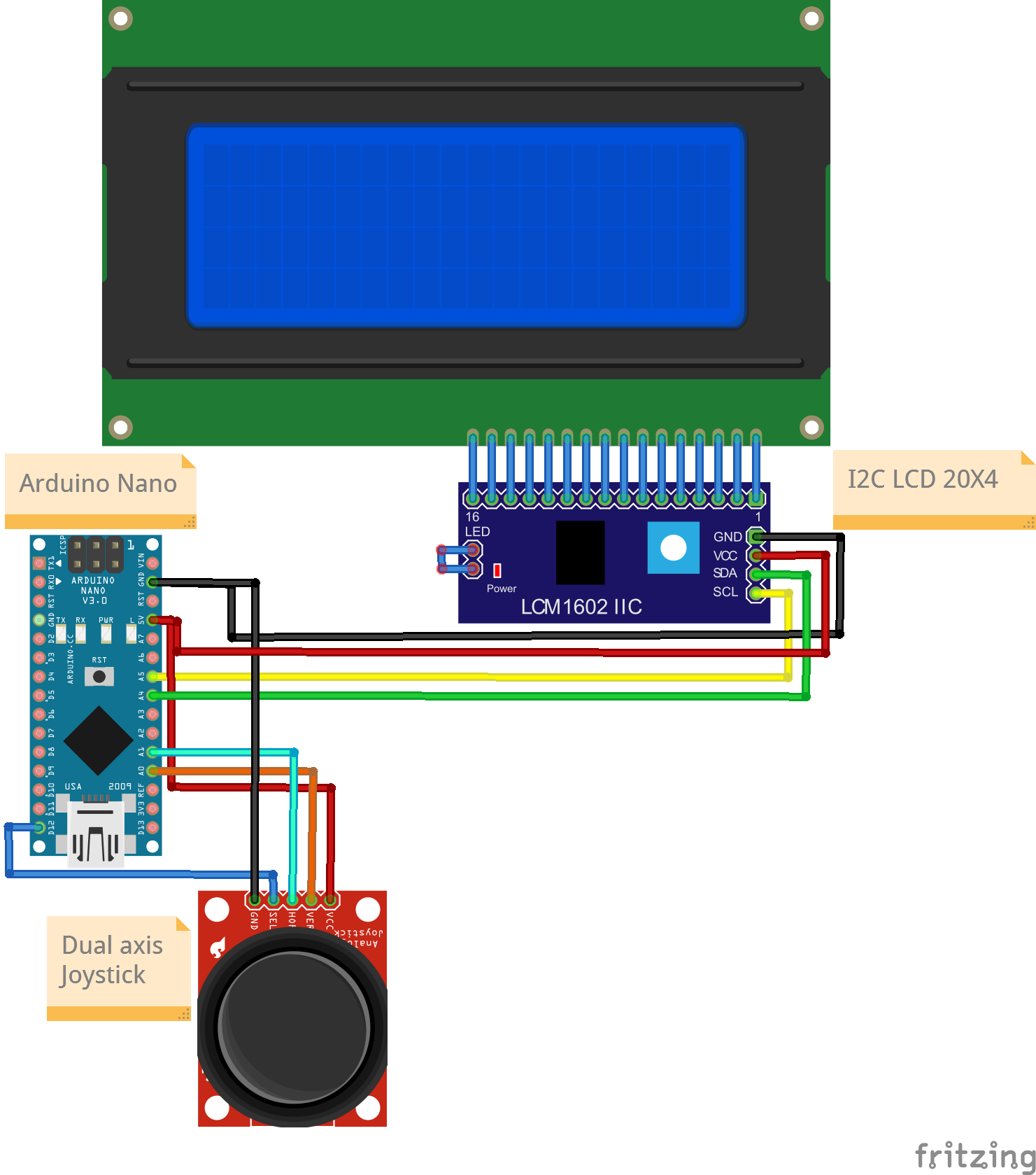Overview
This project reads values from a Joystick and displays the readings on an LCD screen with an I2C backpack. The sketch captures and prints the following parameters:-
- Select pin status (pressed/not pressed)
- Direction the joystick has been pushed:
- North
- South
- East
- West
- North West
- North East
- South West
- South East
Components
| Component | Purpose | Comm. Protocol | Current | Voltage |
|---|---|---|---|---|
| Arduino Nano | The microcontroller | - | 500mA | 5V |
| I2C LCD 20X4 | LCD display | I2C | 120mA | 5V |
| Dual axis joystick | Joystick for input | - | - | - |
Circuit Diagram

Connections
Dual-axis Joystick Pin Connections
| Nano Pin | Joystick Pin |
|---|---|
| A0 | vertical pin |
| A1 | horizontal pin |
| D12 | select pin |
| 5V | VCC |
| Gnd | Gnd |
I2C LCD Pin Connections
| Nano Pin | I2C LCD Pin |
|---|---|
| A4 | SDA |
| A5 | SCL |
| 5V | VCC |
| GND | GND |
Code
/*
Project: Joystick input with output as LCD with I2C Backpack
Project Description:
This sketch writes data from the joystick input to an LCD display module.
This sketch is for a 20x4 screen.
Author: STEMVentor Educonsulting
This code is copyrighted. Please do not reuse or share for any purpose other than for learning with subscribed STEMVentor programs.
This code is for educational purposes only and is not for production use.
*/
// LIBRARIES
#include <Wire.h> // Used for communicating with I2C devices
// Install the LiquidCrystal I2C by Frank de Brabander from the IDE library manager.
#include <LiquidCrystal_I2C.h>
// PIN DEFINITIONS
// For Arduino Nano
// #define VertPin A1
// #define HorzPin A0
// #define SelPin 12
// For ESP32
#define VertPin 12
#define HorzPin 13
#define SelPin 14
// GLOBAL VARIABLES
// Define the display size
const byte Rows = 4;
const byte Cols = 20;
// Since range of analog values read by Arduino Nano is between 0-1024 and analog values read by ESP32 is 0-4096.
// For Arduino Nano
// const int NorthThreshold = 750;
// const int SouthThreshold = 250;
// const int WestThreshold = 750;
// const int EastThreshold = 250;
// For ESP32
const int NorthThreshold = 3200;
const int SouthThreshold = 1200;
const int WestThreshold = 3200;
const int EastThreshold = 1200;
// used for display string on lcd
/* INITIALIZE OBJECTS */
LiquidCrystal_I2C lcd(0x27, Cols, Rows);
/* LOCAL FUNCTIONS */
// Read sensor value
void readJoystickValue()
{
bool center = 1; // Default value set to 1 to assume the joystick is in center
joystickPosition.remove(0); // Empty the string
int vert = analogRead(VertPin); // Read the vertical pin value
int horz = analogRead(HorzPin); // Read the horizontal pin value
bool selPressed = digitalRead(SelPin) ; // Read the sel pin value
// Serial print the values
Serial.println(vert);
Serial.println(horz);
Serial.println(selPressed);
// Position identification logic (Can be altered)
// Three checks -> vertical line, horizontal line, and whether the button is pressed or not
if (selPressed == 0){
joystickPosition += "P"; // Pressed
}
else if (selPressed == 1 ){
joystickPosition += "NP"; // Not pressed
}
if (vert > NorthThreshold){
joystickPosition += " North"; // Pushed towards north
center = 0;
}
else if (vert < SouthThreshold){
joystickPosition += " South"; // Pushed towards south
center = 0;
}
if (horz > WestThreshold){
joystickPosition += " West"; // Pushed towards west
center = 0;
}
else if (horz < EastThreshold){
joystickPosition += " East"; // Pushed towards east
center = 0;
}
if (center == 1 ){
joystickPosition += " Center"; // Is in center
}
}
/*
Function to print to LCD on a single row.
Takes the row number and the text to display on that row (max 20 chars, rest will be truncated).
The entire display is cleared if the clearAll flag is true, else only the row is cleared (the default).
*/
void printToLCDByRow(int row, String text, bool clearAll = false)
{
const char* twentySpaces = " ";
if(clearAll){
lcd.clear(); // Clears the entire display
}
lcd.setCursor(0, row-1);
lcd.print(twentySpaces); // Clears the row
lcd.setCursor(0, row-1); // Cursor has to be set again after printing spaces
lcd.print(text);
}
/*
Function to print to LCD across rows with each row having 20 chars.
Messages can be a maximum of 20x4 chars, rest will be truncated.
The entire display is cleared before printing the text.
*/
void printToLCD(String text)
{
lcd.clear(); // Clears the entire display
byte charsRemaining = text.length();
byte charFrom = 0;
byte charTo = charsRemaining < Cols ? text.length() : charFrom + Cols;
byte row = 1;
while(charsRemaining > 0){
String line = text.substring(charFrom, charTo);
printToLCDByRow(row, line);
charsRemaining = text.length() - charTo;
charFrom = charTo;
charTo = charsRemaining < Cols ? text.length() : charFrom + Cols;
row++;
}
Serial.println("Data string has been displayed on LCD");
}
void lcdSetup() // Function to LCD setup
{
// Initializing wire
Wire.begin();
// Initialize the LCD.
lcd.init();
// Turn on the backlight and print a message.
lcd.backlight();
// Use the function to display text on each line individually.
printToLCDByRow(1, "I2C LCD Ready!", true);
printToLCDByRow(2, "Enter some text.", false);
printToLCDByRow(3, "Max 80 characters.", false);
printToLCDByRow(4, "For a 20x4 LCD.", false);
}
void joystickSetup()
{
// Joystick pins
pinMode(VertPin, INPUT);
pinMode(HorzPin, INPUT);
// for ESP32
pinMode(SelPin, INPUT_PULLUP);
// for Arduino Nano
pinMode(SelPin, INPUT);
}
/* SETUP CODE: runs once when the board starts up or resets */
void setup() {
// Start the serial communication with baud rate suitable for your components.
Serial.begin(9600);
lcdSetup();
joystickSetup();
Serial.println("The board is ready!");
printToLCDByRow(1, "Joystick Position:", true);
}
/* MAIN LOOP: runs repeatedly at a very high frequency (1000s of times a second) */
void loop() {
delay(1000);
readJoystickValue();
printToLCDByRow(2, joystickPosition, false);
}